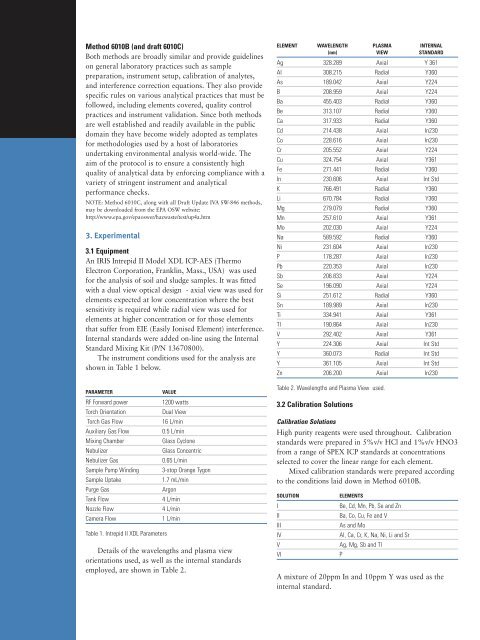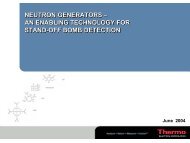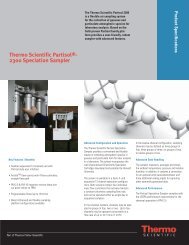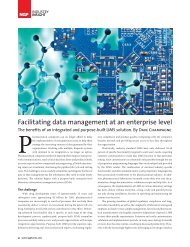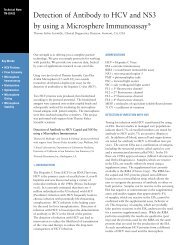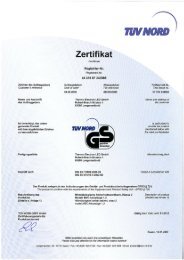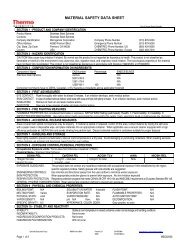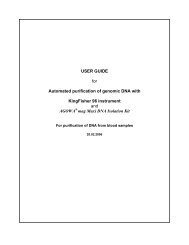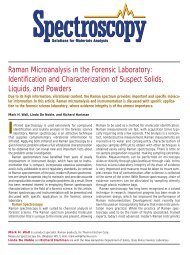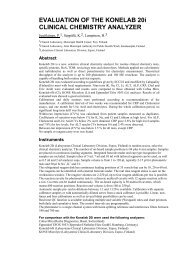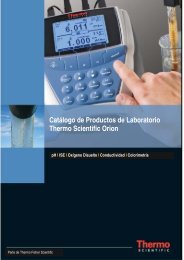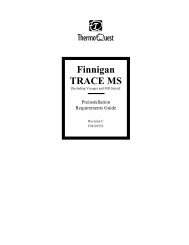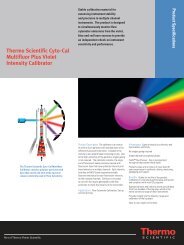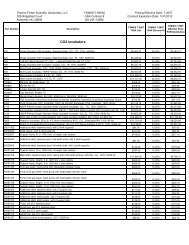8 Hour Stability
8 Hour Stability
8 Hour Stability
Create successful ePaper yourself
Turn your PDF publications into a flip-book with our unique Google optimized e-Paper software.
Method 6010B (and draft 6010C)<br />
Both methods are broadly similar and provide guidelines<br />
on general laboratory practices such as sample<br />
preparation, instrument setup, calibration of analytes,<br />
and interference correction equations. They also provide<br />
specific rules on various analytical practices that must be<br />
followed, including elements covered, quality control<br />
practices and instrument validation. Since both methods<br />
are well established and readily available in the public<br />
domain they have become widely adopted as templates<br />
for methodologies used by a host of laboratories<br />
undertaking environmental analysis world-wide. The<br />
aim of the protocol is to ensure a consistently high<br />
quality of analytical data by enforcing compliance with a<br />
variety of stringent instrument and analytical<br />
performance checks.<br />
NOTE: Method 6010C, along with all Draft Update IVA SW-846 methods,<br />
may be downloaded from the EPA OSW website:<br />
http://www.epa.gov/epaoswer/hazwaste/test/up4a.htm<br />
3. Experimental<br />
3.1 Equipment<br />
An IRIS Intrepid II Model XDL ICP-AES (Thermo<br />
Electron Corporation, Franklin, Mass., USA) was used<br />
for the analysis of soil and sludge samples. It was fitted<br />
with a dual view optical design - axial view was used for<br />
elements expected at low concentration where the best<br />
sensitivity is required while radial view was used for<br />
elements at higher concentration or for those elements<br />
that suffer from EIE (Easily Ionised Element) interference.<br />
Internal standards were added on-line using the Internal<br />
Standard Mixing Kit (P/N 13670800).<br />
The instrument conditions used for the analysis are<br />
shown in Table 1 below.<br />
PARAMETER VALUE<br />
RF Forward power 1200 watts<br />
Torch Orientation Dual View<br />
Torch Gas Flow 16 L/min<br />
Auxiliary Gas Flow 0.5 L/min<br />
Mixing Chamber Glass Cyclone<br />
Nebulizer Glass Concentric<br />
Nebulizer Gas 0.65 L/min<br />
Sample Pump Winding 3-stop Orange Tygon<br />
Sample Uptake 1.7 mL/min<br />
Purge Gas Argon<br />
Tank Flow 4 L/min<br />
Nozzle Flow 4 L/min<br />
Camera Flow 1 L/min<br />
Table 1. Intrepid II XDL Parameters<br />
Details of the wavelengths and plasma view<br />
orientations used, as well as the internal standards<br />
employed, are shown in Table 2.<br />
ELEMENT WAVELENGTH PLASMA INTERNAL<br />
(nm) VIEW STANDARD<br />
Ag 328.289 Axial Y 361<br />
Al 308.215 Radial Y360<br />
As 189.042 Axial Y224<br />
B 208.959 Axial Y224<br />
Ba 455.403 Radial Y360<br />
Be 313.107 Radial Y360<br />
Ca 317.933 Radial Y360<br />
Cd 214.438 Axial In230<br />
Co 228.616 Axial In230<br />
Cr 205.552 Axial Y224<br />
Cu 324.754 Axial Y361<br />
Fe 271.441 Radial Y360<br />
In 230.606 Axial Int Std<br />
K 766.491 Radial Y360<br />
Li 670.784 Radial Y360<br />
Mg 279.079 Radial Y360<br />
Mn 257.610 Axial Y361<br />
Mo 202.030 Axial Y224<br />
Na 589.592 Radial Y360<br />
Ni 231.604 Axial In230<br />
P 178.287 Axial In230<br />
Pb 220.353 Axial In230<br />
Sb 206.833 Axial Y224<br />
Se 196.090 Axial Y224<br />
Si 251.612 Radial Y360<br />
Sn 189.989 Axial In230<br />
Ti 334.941 Axial Y361<br />
Tl 190.864 Axial In230<br />
V 292.402 Axial Y361<br />
Y 224.306 Axial Int Std<br />
Y 360.073 Radial Int Std<br />
Y 361.105 Axial Int Std<br />
Zn 206.200 Axial In230<br />
Table 2. Wavelengths and Plasma View used.<br />
3.2 Calibration Solutions<br />
Calibration Solutions<br />
High purity reagents were used throughout. Calibration<br />
standards were prepared in 5%v/v HCl and 1%v/v HNO3<br />
from a range of SPEX ICP standards at concentrations<br />
selected to cover the linear range for each element.<br />
Mixed calibration standards were prepared according<br />
to the conditions laid down in Method 6010B.<br />
SOLUTION ELEMENTS<br />
I Be, Cd, Mn, Pb, Se and Zn<br />
II Ba, Co, Cu, Fe and V<br />
III As and Mo<br />
IV Al, Ca, Cr, K, Na, Ni, Li and Sr<br />
V Ag, Mg, Sb and Tl<br />
VI P<br />
A mixture of 20ppm In and 10ppm Y was used as the<br />
internal standard.


